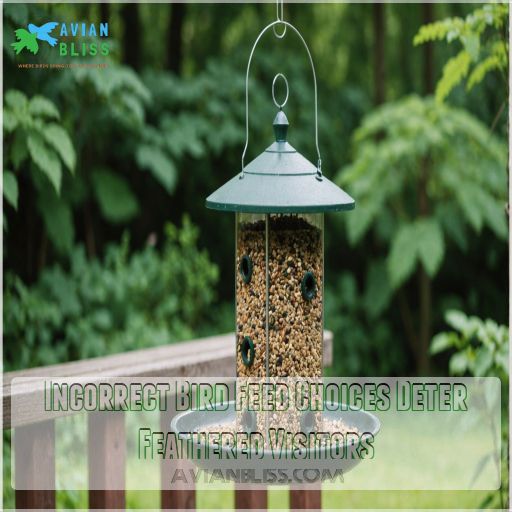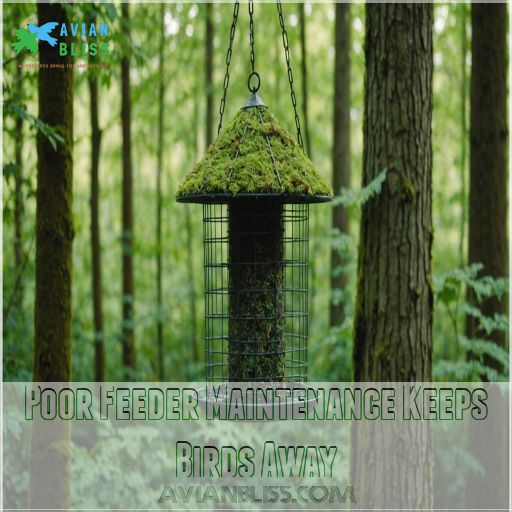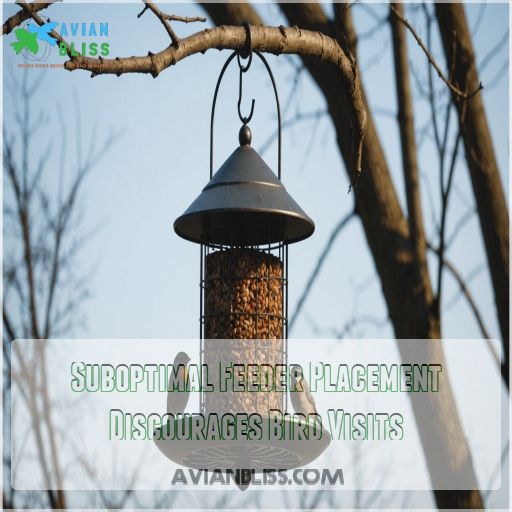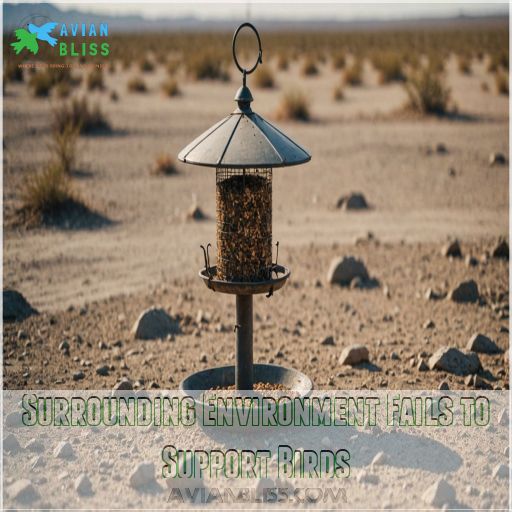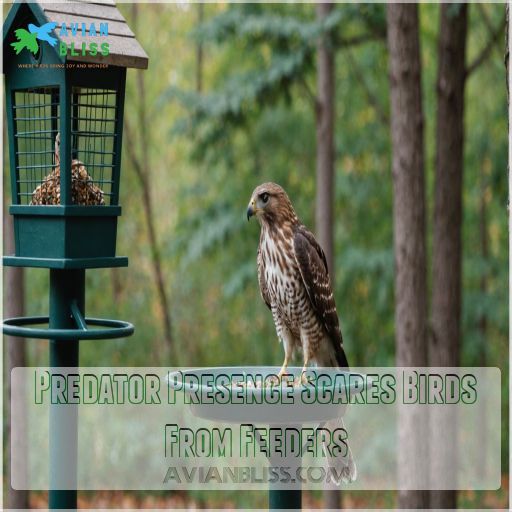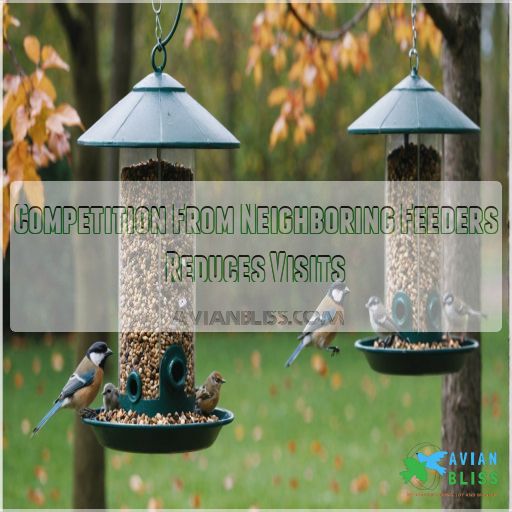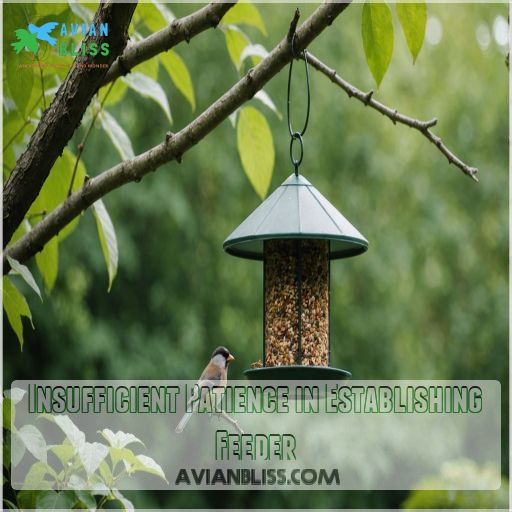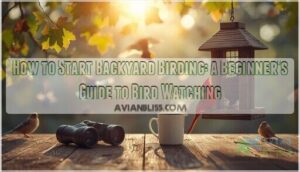This site is supported by our readers. We may earn a commission, at no cost to you, if you purchase through links.
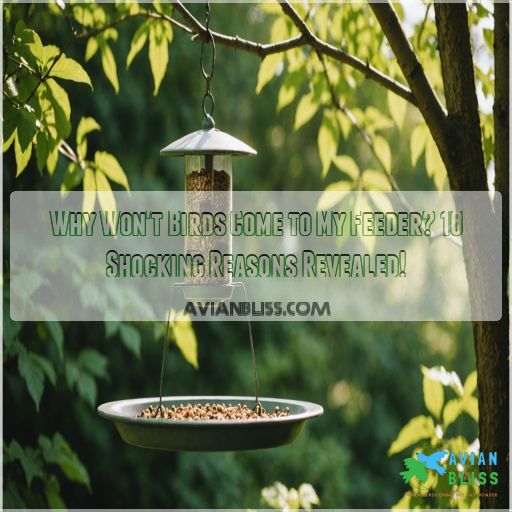
Think gourmet—black oil sunflower seeds are like filet mignon to our feathered friends.
If feeders are dirty, it’s like serving dinner on a dirty plate—no thanks! And location matters; no self-respecting bird wants to dine in a noisy, traffic-jam spot.
Add some squirrel-proofing and bird baths to spruce up their lodge. Want to uncover more feeder faux pas and secrets of bird allure? Stick around!
Table Of Contents
- Key Takeaways
- Incorrect Bird Feed Choices Deter Feathered Visitors
- Poor Feeder Maintenance Keeps Birds Away
- Suboptimal Feeder Placement Discourages Bird Visits
- Inadequate Feeder Types Limit Bird Attraction
- Surrounding Environment Fails to Support Birds
- Predator Presence Scares Birds From Feeders
- Seasonal Factors Affect Bird Feeder Visits
- Timing Issues Lead to Missed Bird Activity
- Competition From Neighboring Feeders Reduces Visits
- Insufficient Patience in Establishing Feeder
- Frequently Asked Questions (FAQs)
- Why are birds not coming to my bird feeder?
- Why did hummingbirds not come to my feeder?
- Why do birds stop visiting feeders?
- Will birds come back to my feeders?
- Is it normal for birds to not use a new feeder?
- Why does my bird feeder go bad?
- Why are there no birds at my feeder?
- Why isn’t my bird feeder attracting birds?
- How do I get birds to come to my feeder?
- How long does it take for birds to discover a new feeder?
- Can dirty feeders deter birds from visiting?
- How do environmental toxins affect bird visits?
- Do high temperatures influence feeder activity?
- Can bird illness affect feeder attraction?
- Might injured birds avoid feeders altogether?
- Conclusion
Key Takeaways
- Keep it gourmet to attract birds; think of black oil sunflower seeds as the filet mignon of bird food. Ditch those filler seeds, like red milo and cracked corn—they’re akin to serving plain rice at a five-star dinner.
- Location, location, location! Ensure your feeder isn’t in a traffic-jam zone. Birds are just like us—they prefer a peaceful dining spot. Keep predators, like cats and squirrels, at bay, and offer some nearby perches for a safe escape route.
- Cleanliness is king. A grimy feeder is like a restaurant with a one-star health rating—birds won’t touch it. Make it a monthly ritual to scrub the feeders clean and keep the seeds fresh. A clean feeder is a bird’s happy place.
- Patience, grasshopper. Birds might take time to discover your feeder, especially during seasons when natural food is bountiful. Stick with it, provide a variety of foods, and watch as your yard slowly fills with a rainbow of feathered friends.
Incorrect Bird Feed Choices Deter Feathered Visitors
You’ve set up a bird feeder, but your feathered friends are nowhere to be seen.
The culprit might be lurking in your seed choices.
From filling feeders with cheap, filler-heavy mixes to offering stale or inappropriate foods, your well-intentioned efforts could be sending birds flying in the opposite direction due to the opposite direction being an unintended consequence.
Excessive Filler Seeds Like Red Milo and Cracked Corn
You’ve filled up your feeder, but the birds aren’t biting?
It might be time to take a closer look at what you’re serving. Excessive filler seeds like red milo and cracked corn can turn your bird buffet into a flop.
Many birds simply don’t have a taste for these budget-friendly options . Instead of attracting a diverse flock, you might end up with a pile of wasted seed and some very disappointed feathered friends.
This could result in a pile of wasted seed.
Offering Human Food Scraps Instead of Proper Bird Feed
Many well-meaning bird enthusiasts make the mistake of offering human food scraps to their feathered friends.
While it might seem like a kind gesture, this practice can actually harm birds and drive them away from your feeder.
Human foods often lack the necessary nutrients birds need and can even be toxic . Instead of bread crumbs or table scraps, stick to bird-specific feeds that cater to their natural diet and preferences, such as those that provide the nutrients needed to keep birds healthy and thriving in their natural diet.
Using Stale or Moldy Bird Seed
Stale birdseed is like serving your feathered friends a plate of disappointment.
Your backyard buffet might be gathering dust if you’re not vigilant about seed freshness.
Moldy or damp seeds can spell trouble, potentially making birds sick or driving them away.
Keep an eye out for clumping, unusual odors, or color changes in your seed supply.
Remember, a happy bird is a well-fed bird with fresh, nutritious seeds and a backyard buffet.
Insufficient Variety in Seed Types
A wide variety of seeds is key to attracting diverse feathered friends. You might be unintentionally creating a "bird buffet bust" by offering limited options.
Different species have unique preferences . To turn your feeder into a bustling avian hotspot, consider these seed superstars:
- Black oil sunflower seeds
- Safflower seeds
- Nyjer (thistle) seeds
- White proso millet
- Peanuts
Mix it up to keep the birds coming back for more!
Poor Feeder Maintenance Keeps Birds Away
You’ve set up your feeder, but the birds aren’t flocking to it?
Poor maintenance could be the culprit, turning your well-intentioned bird buffet into an unwelcome dining experience for our feathered friends.
Let’s explore how neglecting feeder upkeep might be inadvertently giving birds the cold shoulder and what you can do to roll out the red carpet for your backyard visitors, and create a welcoming environment with proper feeder upkeep.
Dirty or Contaminated Feeders Repel Birds
Birds are picky eaters, and not just about their seeds. A dirty feeder is like a five-star restaurant with a health code violation – they’ll fly right by. Your feathered friends have keen senses and can spot (or smell) a grimy dining spot from afar.
Let’s look at why clean feeders matter:
| Dirty Feeder Dangers | Bird Reaction | Your Action |
|---|---|---|
| Mold growth | Avoid feeder | Scrub thoroughly |
| Bacteria buildup | Fall ill | Disinfect regularly |
| Spoiled seed | Seek food elsewhere | Replace promptly |
| Droppings accumulation | Spread disease | Clean daily |
| Pest infestation | Abandon area | Monitor closely |
Keeping your feeders pristine isn’t just about aesthetics – it’s a matter of life or death for our avian amigos.
Infrequent Cleaning and Disinfection of Feeders
Clean your feeders! You wouldn’t eat off a dirty plate, and neither will your feathered friends.
Infrequent cleaning can turn your bird buffet into a bacterial breeding ground.
Wild Birds Unlimited recommends washing feeders at least once a month . Think of it as giving your backyard bistro a health inspection – it’ll keep the birds coming back for more and singing your praises!
Allowing Feeders to Remain Empty for Extended Periods
You’ve scrubbed your feeder squeaky clean, but the birds still aren’t flocking?
empty feeders are like ghosted dinner invitations. Birds are creatures of habit, and if they swing by your "restaurant" only to find it closed, they’ll take their business elsewhere (Source).
Consistency is key in the bird world. Keep those feeders filled, and you’ll be the talk of the avian town!
Failing to Replace Wet or Spoiled Seed Promptly
Wet seed often results from using low-quality birdseed mixes that don’t provide essential nutrients, try making your own homemade bird food recipes with healthy ingredients to attract more birds; isn’t just unappetizing; it’s a recipe for disaster in your bird feeder. When you let soggy seeds linger, you’re rolling out the red carpet for:
- Fuzzy mold colonies
- Sprouting seed jungles
- Rancid seed buffets
These conditions can turn your feeder into a haven for avian diseases and infections. Don’t let your backyard buddies feast on moldy morsels. Keep your feeder clean and dry, and your feathered friends will thank you with their cheerful presence.
Neglecting to Refill Feeders Daily, Especially in Mornings
Birds are creatures of habit, and consistency is key in your feeder adventure.
If you’re not refilling daily, especially during the early morning chorus, you might be missing out on the avian breakfast rush.
Your feathered friends rely on that predictable morning feast to fuel their day. By neglecting this important routine, you’re inadvertently telling them to seek sustenance elsewhere.
Suboptimal Feeder Placement Discourages Bird Visits
You’ve set up your bird feeder with care, but the birds still aren’t flocking to it?
The location of your feeder could be the culprit , as suboptimal placement can discourage our feathered friends from paying a visit.
Feeders Positioned Too High or Too Low
Three key factors determine the perfect bird feeder height: species preference, safety, and convenience.
Most backyard birds happily dine at feeders positioned 5-6 feet high . However, ground feeders like sparrows prefer 1-5 feet, while woodpeckers and orioles enjoy heights of 6-10 feet.
Remember, it’s not just about attracting birds – you’ll want to outsmart those clever squirrels and keep your feathered friends safe from prowling cats too!
Lack of Nearby Shelter or Protective Cover
Near your feeder, birds crave a safe haven. Without nearby shelter, they’re sitting ducks for predators.
Your feeder’s goal? A bird buffet with built-in bodyguards! Trees and shrubs are nature’s security team, offering quick getaways when danger strikes (Source).
Think of it as giving your feathered friends a cozy break room between meals. No cover? You’re practically asking birds to dine and dash, making them like sitting ducks for predators.
Feeders Placed in High-Traffic or Noisy Areas
You’ve set up your feeder, but it’s as quiet as a church mouse. Just like us, birds prefer a peaceful dining experience. High-traffic or noisy areas can ruffle their feathers, making them fly the coop .
To create a bird feeder haven that’ll have them chirping with joy:
- Place feeders away from busy roads
- Avoid areas near noisy machinery
- Keep distance from active play areas
- Steer clear of windchimes or other noisy decorations
- Choose spots sheltered from strong winds
Insufficient Distance From Trees (Squirrel Access)
While noise might scare off birds, your feeder’s proximity to trees could be the real culprit.
Squirrels are acrobatic opportunists, and if your feeder’s within their jumping range, you’re practically running a squirrel buffet .
To keep these furry acrobats at bay, place your feeders at least 10 feet from trees or overhanging branches.
Remember, a well-placed feeder is a happy feeder – for birds and bird-watchers alike, which makes for a happy feeder.
Absence of Staging Perches Near Feeders
Three simple words can make all the difference: "If you build it, they’ll come." But when it comes to bird feeders, you need more than just the feed.
Staging perches near your feeders is really important for attracting our feathered friends. They provide:
- A safe spot to survey the area
- A chance to catch their breath before diving in
- A place to crack open those tough seeds
- An opportunity for a quick preening session
Without these pit stops, you might be unknowingly turning your yard into a bird-free zone .
Inadequate Feeder Types Limit Bird Attraction
You might think any bird feeder will do, but choosing the wrong type can actually discourage feathered friends from visiting.
From platform feeders to tube feeders and specialized options like suet cages, each style caters to different bird species and their unique feeding habits, which can actually include different bird species.
Using Only One Type of Bird Feeder
If you’re scratching your head wondering why your feeder’s a ghost town, it might be time to shake things up!
Relying on just one type of bird feeder is like serving a one-dish meal at a potluck – you’ll miss out on the party.
Different birds have unique dining preferences, so offering a smorgasbord of feeder styles can turn your yard into a bustling avian hotspot .
Incorrect Feeder Styles for Target Bird Species
When it comes to attracting birds, one size doesn’t fit all in the feeder world.
You might be using the wrong style for your target species, leaving your backyard birdwatching dreams unfulfilled.
Think of it as a bird feeder renaissance – each species has its preferences for feeder size, shape, and even color.
Tube feeders might attract finches, while platform feeders are perfect for cardinals and jays.
It’s time to join the bird feeder movement and cater to your feathered friends’ unique tastes, and experience your own personal backyard birdwatching dreams.
Lack of Specialized Feeders (e.g., Suet, Hummingbird)
You’ve set the table, but are you serving the right dishes? Different birds have unique dining preferences. By offering specialized feeders, you’re rolling out the red carpet for a diverse avian crowd.
- Suet feeders attract woodpeckers, nuthatches, and chickadees
- Hummingbird feeders bring in these tiny aerial acrobats
- Nyjer feeders are goldfinch magnets
- Window feeders provide up-close views of feathered friends
Expanding your feeder menu is like joining the bird feeder brotherhood – you’ll soon be part of a lively backyard bird buffet!
Feeders With Too Few Perches or Feeding Ports
Your bird feeder’s design might be giving the cold shoulder to potential visitors.
Imagine a tiny café with just one table – that’s what a feeder with too few perches or ports feels like to birds.
It’s a recipe for feathered frustration. Overcrowding leads to bird aggression, while limited access points can turn mealtime into a game of musical chairs.
Consider upgrading to a feeder with multiple ports and ample perch spacing to create a bird-friendly buffet .
Absence of Squirrel-Proof Feeder Options
Pesky squirrels raiding your feeders? It’s time for a bird feeder revolution!
Without squirrel-proof options, you’re rolling out the red carpet for these furry thieves.
Invest in a caged feeder or one with weight-activated perches to keep the squirrels at bay . These clever designs make sure your feathered friends can dine in peace, while squirrels are left scratching their heads.
It’s like creating a VIP lounge for birds only!
Surrounding Environment Fails to Support Birds
You’ve set up your feeder, but the birds are still a no-show?
It might be time to take a closer look at your yard – turns out, creating a bird-friendly environment is just as important as the feeder itself.
Lack of Natural Landscaping and Native Plants
Birds aren’t just looking for a quick snack at your feeder. They’re searching for a complete habitat. A barren yard won’t cut it.
Native plants provide more than just food – they offer shelter, nesting spots, and protection from predators .
Think of your garden as a multi-level bird buffet.
Tall trees, shrubs, and wildflowers create a diverse ecosystem that’ll have birds flock to your yard in no time.
Absence of Water Sources Like Bird Baths
Don’t underestimate the power of water in attracting birds to your yard.
Just like us, feathered friends need a reliable water source for drinking and bathing. Without a bird bath, you’re missing out on a key element that can make or break your backyard bird paradise.
Birds prefer shallow water, so aim for about an inch or two deep . Keep it fresh and clean to make sure your feathered visitors keep coming back for more, to make it a reliable water source.
Use of Chemical Pesticides or Fertilizers in Yard
You’ve likely overlooked a silent bird deterrent in your yard: chemical pesticides and fertilizers. These substances can be harmful to our feathered friends, potentially poisoning them or depleting their food sources.
While you’re aiming for a lush lawn, you might be inadvertently creating an unsafe environment.
Consider switching to organic alternatives or essential-oil-derived insecticides. Remember, a bird-friendly yard isn’t just about feeders—it’s about creating a safe, inviting ecosystem.
Insufficient Trees or Shrubs for Cover and Nesting
Without a doubt, your feathered friends need more than just a buffet. They’re looking for a cozy neighborhood with all the amenities.
If your yard’s lacking in the leafy department, birds might be hesitant to stick around.
Trees and shrubs aren’t just pretty – they’re essential pit stops for birds, offering shelter from predators and weather, plus prime real estate for nest-building . It’s like trying to attract guests to a house party without any comfy seating, which can be a major house party drawback.
Lack of Diverse Habitats in the Immediate Area
Many bird species rely on a variety of habitats for their survival. Your yard might be missing the mark if it’s a one-trick pony.
Birds thrive in diverse environments that mimic their natural habitats.
To attract a wider range of feathered friends, consider creating a mini-ecosystem in your backyard:
- Plant a wildflower meadow for seed-loving songbirds
- Install a small pond for water-loving species
- Create a brush pile for ground-dwelling birds
- Add native berry-producing shrubs for fruit eaters
Predator Presence Scares Birds From Feeders
You’ve set up the perfect bird feeder, but your feathered friends are nowhere to be seen.
The culprit might be lurking nearby – predators can turn your bird-friendly oasis into a no-fly zone faster than you can say "here, birdie birdie!
Nearby Cats or Dogs Frightening Birds
Your furry friends might be the culprits behind your bird-free feeders. Cats and dogs, natural predators, can scare away even the bravest feathered visitors.
They have a keen sense of danger, and the mere presence of these four-legged threats can turn your yard into a no-fly zone.
Remember, our pets are just following their instincts – they’re not trying to ruin your birdwatching dreams!
Consider creating safe spaces for birds to enjoy their meals undisturbed.
Presence of Hawks or Other Predatory Birds
Hawks and other predatory birds can turn your bustling feeder into a ghost town.
These swift hunters often perch high in trees, waiting to ambush unsuspecting songbirds.
You might notice sudden silence or a flurry of fleeing feathers when they’re around.
To keep your feathered friends safe, try placing feeders near dense cover or under protective awnings .
Remember, while it’s thrilling to spot a raptor, it’s not so fun for your regular visitors!
Squirrel Overpopulation at Feeders
While you might think your bird feeder is a backyard oasis, squirrel overpopulation can turn it into a no-fly zone for our feathered friends.
These bushy-tailed acrobats don’t just steal seeds; they scare away birds with their constant activity.
To reclaim your feeder paradise:
- Install squirrel-proof feeders with weight-activated perches
- Use safflower or nyjer seeds, which squirrels dislike
- Try hot pepper oil-infused seed cylinders for a spicy surprise
Snakes or Other Ground Predators in Vicinity
Slithering serpents and sneaky ground predators can turn your bird feeder into a ghost town faster than you can say "snake in the grass."
While squirrels might be pesky, snakes can be downright terrifying for our feathered friends. One gardener learned this the hard way when a snake invaded her birdhouse, transforming it into an unwelcome "snake feeder" .
Let’s explore how to keep your yard safe:
| Predator | Threat Level | Deterrent |
|---|---|---|
| Snakes | High | Slinky |
| Rodents | Medium | Pole guards |
| Voles | Low | Clean-up |
Human Activity Too Close to Feeding Areas
Your feathered friends are more skittish than you might think. Human activity near feeders can send them flying faster than you can say "birdseed."
- Constant foot traffic through your yard
- Noisy outdoor activities or gatherings
- Pets roaming freely near feeders
- Regular yard maintenance like mowing or pruning
- Frequent adjustments or refilling of feeders
Remember, birds need to feel safe to stick around. Try creating a "bird-friendly zone" away from the hustle and bustle of your daily life.
Seasonal Factors Affect Bird Feeder Visits
You might be surprised to learn that the seasons play a huge role in whether birds visit your feeder.
As the year progresses, changes in food availability, migration patterns, and weather can all impact how often feathered friends stop by for a snack.
Natural Food Abundance During Spring and Summer
Spring and summer bring a bird buffet to your backyard! Nature’s pantry is suddenly stocked with juicy insects, fresh berries, and tender seeds.
Your feathered friends aren’t snubbing you; they’re just spoiled for choice.
During nesting season, birds need protein-rich natural foods to fuel their busy schedules.
Don’t take it personally if your feeders see less traffic – it’s just Mother Nature’s way of providing a seasonal smorgasbord!
Migration Patterns Altering Local Bird Populations
During peak migration seasons, you might notice a sudden shift in your feathered visitors.
As birds set out on their long journeys, your local population can change dramatically . Don’t be surprised if your regular chickadees are replaced by unfamiliar faces!
This natural ebb and flow of bird species can leave your feeders feeling like ghost towns one week and bustling avian airports the next.
Keep those feeders stocked – you never know who might drop in for a pit stop!
Weather Conditions Impacting Feeding Habits
Weather plays a significant role in birds’ feeding habits.
As temperatures fluctuate, you might notice changes in feeder activity. Extreme heat can reduce visits, as birds seek cooler spots.
Rainfall impacts where and when birds breed, affecting their presence at feeders . Wind and humidity also influence foraging patterns.
Remember, birds need to stay active to find food, so don’t be discouraged if you see fewer visitors during unusual weather – they’re likely adapting their behavior to survive.
Winter Scarcity Increasing Feeder Dependence
Winter’s chill brings feathered friends flocking to your feeder.
As natural food sources dwindle, birds become more dependent on supplemental feeding .
You’ll notice increased activity at your feeders, especially from small-bodied songbirds like chickadees with high energy needs.
To help them through the lean times, offer high-fat options like black-oil sunflower seeds and suet cakes.
Keep those feeders full and clean – you’re their winter lifeline!
Timing Issues Lead to Missed Bird Activity
You might be missing out on feathered visitors simply because of poor timing.
Birds have specific feeding schedules and habits that, if overlooked, can leave you wondering why your feeder seems deserted.
Observing Feeders at Wrong Times of Day
You’ve set up a beautiful feeder, but the birds are still no-shows. The culprit might be your timing. Birds don’t run on human schedules – they follow nature’s clock.
To catch the feathered action, try these prime viewing times:
- Early morning, right after sunrise
- Mid-morning, when they’re actively foraging
- Late afternoon, before sunset
- Brief periods throughout the day
Remember, patience is key. Like clockwork, some birds stick to regular feeding schedules.
Failing to Account for Crepuscular Feeding Habits
In light of birds’ unique dining habits, you might be missing out on peak feeder activity. Many species, including chimney swifts and hummingbirds, are crepuscular feeders, preferring to dine at dawn and dusk.
If you’re not keeping an eye on your feeder during these twilight hours, you’re likely to miss the avian rush hour. Cardinals, for instance, often swoop in for their meals just as the sun sets.
Some birds are crepuscular feeders, which means their feeding times are focused around dawn and dusk.
Not Allowing Sufficient Time for Birds to Discover Feeders
According to bird experts, patience is key when introducing a new feeder to your backyard. It’s not uncommon for our feathered friends to take their sweet time before discovering your culinary offerings.
- Birds need time to adjust to new structures
- Natural food sources may be abundant
- Word-of-beak spreads slowly in the bird community
- Seasonal changes affect feeding patterns
Remember, good things come to those who wait!
Inconsistent Feeding Schedules Disrupting Bird Routines
Birds thrive on routine, and inconsistent feeding can throw them off balance.
Just like your morning coffee ritual, feathered friends rely on regular meal times. If you’re filling feeders sporadically, you’re disrupting their carefully planned schedules.
Imagine showing up to your favorite restaurant only to find it randomly closed – frustrating, right? Consistency is key.
Set a daily feeding time, preferably in the morning, and stick to it. Your winged visitors will thank you with their cheerful presence. By establishing this routine, you’ll be supporting the carefully planned schedules of the birds that visit your feeders.
Overlooking Nocturnal Visits From Certain Species
You might be missing out on some unexpected nighttime visitors!
While many birds are active during the day, some species come alive after dark.
Eastern Screech-Owls, for instance, are nocturnal hunters that might be frequenting your yard without your knowledge.
Even typically diurnal birds like Northern Mockingbirds can sing through the night, especially during breeding season or full moons.
Don’t forget to listen for those nighttime chirps!
Competition From Neighboring Feeders Reduces Visits
You might be surprised to learn that your bird-friendly efforts could be overshadowed by your neighbors’ feeders.
If nearby yards offer more enticing buffets or established feeding territories, your feeder might be getting the cold shoulder from local birds due to established feeding territories.
More Attractive Feeding Stations Nearby
Dozens of neighbors may be vying for the attention of local birds, creating a feathered feeding frenzy. Your feeder might be losing out to more enticing options nearby.
- Superior seed selection
- Strategic feeder placement
- Diverse feeder types
Your backyard birds might be getting the VIP treatment next door, enjoying a smorgasbord of gourmet seeds and prime real estate. It’s like they’ve found the five-star restaurant of the avian world, while your feeder’s still waiting for its Michelin star.
Overabundance of Feeders in the Area
In the midst of a "neighborhood feeder war," your bird buffet might be lost in the crowd.
With a surge in backyard bird feeding, especially during recent stay-at-home periods , you’re facing stiff competition.
When every other yard boasts a feeder, birds have their pick of the litter. This feeder saturation can leave your once-bustling bird cafe feeling like a ghost town.
Neighbors Offering Superior Feed Options
Your neighbor’s birdfeeders might be stealing the show! If they’re offering a gourmet buffet while you’re serving up plain seeds, don’t be surprised if the birds flock next door.
One savvy bird enthusiast even found that water features can be more enticing than seeds.
Consider upping your game with high-quality feed, diverse options, and maybe a bird bath to level the playing field in this neighborly competition for feathered friends.
Established Feeding Territories in Adjacent Yards
Bird feeder competition can feel like a backyard soap opera, with territorial bird behavior stirring up feeding territory disputes.
When neighbor feeder rivalry kicks in, some birds might abandon your yard altogether. Birds establish yard feeder dominance based on established hierarchies.
Often preferring tried-and-true territories next door, they may just fancy your neighbor’s buffet over yours due to yard feeder dominance and a desire for established hierarchies.
Lack of Unique Offerings at Your Feeder
Feeling dwarfed by neighboring feeders packed with bird buffets?
Spice things up with a variety of bird seeds like thistle and suet to attract unique bird species.
Think of it as offering VIP seating at a concert—different feeder designs cater to varied tastes, ensuring you’re not just another stop on the feathered highway.
Insufficient Patience in Establishing Feeder
You’ve set up a new bird feeder, excited for flocks of colorful visitors.
Birds are like fussy food critics—they take their time to discover and trust new dining spots.
So consistent care and some time are essential.
Expecting Immediate Results With New Feeders
Think of setting up a new bird feeder as planting a garden—it requires patience and time.
Birds need to discover your feeder, which might take days or even weeks, as they rely on keen observation and word-of-mouth among their flock.
Be consistent with feeder placement and use popular seeds to improve your chances of attracting these feathered friends.
Failing to Consistently Maintain Feeder Over Time
Don’t let your feeder fall into disrepair!
Consistently maintaining it’s key. Check the seed levels regularly and replace any spoiled or moldy food – birds won’t return to a dirty, neglected feeder [44).
Set a schedule to thoroughly clean and disinfect your feeder at least once a month.
Staying on top of feeder upkeep will keep your backyard birds happy and coming back for more.
Not Adjusting Strategies Based on Bird Preferences
You’ve got the feeder cleaned up, but maybe you’re not tuning into bird preferences. Birds are picky eaters, after all!
Try mixing up seed types like sunflower or safflower to attract different species, and adjust feeder placement or design to suit their habits.
Switch feeding times as well, because the early bird often gets the worm—or in this case, the seed!
Overlooking the Time Required for Word-of-Beak Spread
Patience is key with bird feeders. Birds take time to discover new feeders due to word-of-beak spread, which isn’t instant.
Establish feeder routines and be consistent.
Location matters: place feeders where birds easily see them. A little patience and persistence, like waiting for a shy friend to open up, can yield rewarding feathered visitors, demonstrating that word-of-beak spread isn’t instant.
Giving Up Too Quickly When Results Are Slow
Installing a bird feeder isn’t quite like an instant noodle recipe; it requires patience to see results. Birds take time to adjust.
Consider the following factors to attract birds to your feeder:
- Feeder Consistency: Regular refills attract attention.
- Bird Preferences: Choose seeds carefully.
- Bird Behavior: Observe and adapt.
- Seasonal Impact: Expect changes with weather.
- Adjust Expectations: Progress can be slow.
Hang in there, and soon you’ll tweet with delight! (Source)
Frequently Asked Questions (FAQs)
Why are birds not coming to my bird feeder?
Birds might be snubbing your feeder due to spoiler alert: old, wet seeds, or lurking predators.
Relocate feeders to safe spots and refresh with quality seeds.
Sometimes they prefer nature’s buffet, especially during fall’s feast of abundance , nature’s buffet.
Why did hummingbirds not come to my feeder?
Hummingbirds can be picky guests.
Make sure your feeder is clean.
Filled with the right nectar mix.
And placed in a safe, shaded spot.
Near natural food sources like flowering plants.
Why do birds stop visiting feeders?
The birds might be scared off by new predators or bored with stale seeds.
Maybe they’re overwhelmed by nearby natural food sources or feeling picky about seed types.
Freshen up your offerings and stay hopeful! .
Will birds come back to my feeders?
Fear not; your feathered friends will likely return soon.
Birds often explore natural food sources, but they’ll head back to your feeders when those dwindle.
Just keep your feeders clean and filled—they’re sure to notice.
Is it normal for birds to not use a new feeder?
It’s perfectly normal for birds to take their sweet time discovering a new feeder.
Often, they’re busy enjoying abundant natural food this time of year.
Patience is key; they’ll eventually flock to your setup.
Why does my bird feeder go bad?
Your bird feeder might be going bad due to moldy seeds, attracting predators like cats, or overcrowding by aggressive birds.
Keep your feeder clean, use fresh seeds, and consider placement to minimize issues.
Why are there no birds at my feeder?
Birds might be skipping your feeder due to abundant natural food in fall.
Stale or spoiled seed can be another reason for this.
Make sure you have fresh seed, clean feeders, and safe surroundings to attract them back.
Why isn’t my bird feeder attracting birds?
Think of your feeder as a restaurant for birds—offer fresh, appealing seed and make sure it’s in a safe spot.
Away from predators, the location of the feeder should make the birds feel safe.
Birds might avoid it if the seed’s stale or location feels risky.
How do I get birds to come to my feeder?
Attract birds to your feeder by offering a variety of foods like seeds, suet, and fruit. Hang different feeder styles and place them near natural cover for the best results.
How long does it take for birds to discover a new feeder?
On average, it takes birds from one day to several weeks to find a new feeder.
Patience is key—birds use sight to find food, so make sure your feeder is visible and offers enticing seeds like sunflower.
Can dirty feeders deter birds from visiting?
Dirty feeders can indeed deter birds by harboring bacteria, mold, and parasites, which can make birds sick and spread diseases like Salmonella.
Regular cleaning helps maintain a safe and inviting feeding environment for your feathered visitors.
This helps prevent the spread of diseases and maintain a cleaning routine that is essential for the health of the birds.
How do environmental toxins affect bird visits?
Environmental toxins can harm birds by disrupting their health and habitat.
Pesticides and pollutants can poison birds or impact their food sources, causing population declines and reducing their ability to thrive and visit feeders.
Do high temperatures influence feeder activity?
When the sun blazes, birds act like they’re avoiding a buffet at a sauna!
High temperatures often reduce feeder activity, as they seek shade and conserve energy by eating less and adjusting their activity patterns.
Can bird illness affect feeder attraction?
Bird illness can indeed affect feeder attraction.
Sick birds might avoid visiting feeders, reducing their activity.
Diseases like conjunctivitis spread easily where birds congregate, so keeping feeders clean helps reduce transmission risks and encourages healthy bird visits .
Might injured birds avoid feeders altogether?
If an injured bird avoids your feeder, it might be because it perceives the area as risky.
Injury often impacts mobility or behavior, making feeding more challenging.
Conclusion
Figuring out the secrets to your feathered friends’ affection is like cracking a delightful birdfeeder code.
By addressing the common pitfalls outlined here, you’ll soon have your backyard buzzing with a vibrant avian community.
Embrace your inner bird whisperer, sprinkle some gourmet sunflower seeds, and watch as your why-won’t-birds-come-to-my-feeder woes transform into a chirping celebration.
The key is patience and a dash of creativity—your backyard oasis awaits!

